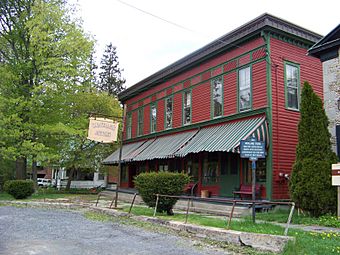Sherwood Equal Rights Historic District facts for kids
Quick facts for kids |
|
|
Sherwood Equal Rights Historic District
|
|
 |
|
| Location | Sherwood Rd. & NY 34B, Sherwood, New York |
|---|---|
| Area | 30 acres (12 ha) |
| Architectural style | Federal, Greek Revival |
| MPS | Freedom Trail, Abolitionism, and African American Life in Central New York MPS |
| NRHP reference No. | 08000096 |
| Added to NRHP | February 29, 2008 |
The Sherwood Equal Rights Historic District is a special area in Sherwood, New York. It is located in Cayuga County, New York. This district is a "historic district." This means it's a place with many old buildings and sites. These places are important because of their history.
The Sherwood district has 29 properties. These include 27 main buildings and a cemetery. There are also three old carriage houses. The district covers the whole small town of Sherwood. It has shops and public buildings too. These places remind us of the Quaker community. Quakers are also called Friends. They worked hard for equal rights. They supported ending slavery, women's rights, and education for everyone.
Contents
Sherwood's History: A Place for Change
Sherwood was first settled in 1794. It was built on land that once belonged to the Cayuga people. People could reach Sherwood by land and water. This made it a busy trading center. The community was a mix of Quaker families. They came from nearby areas and England. There were also freed slaves of African descent. Many people traveled or had ties to other towns.
Fighting for Freedom: Abolitionism
Quaker beliefs shaped the town. They believed in ending slavery, supporting women's rights, and education. Many famous reformers visited Sherwood. These included Abby Kelley, Harriet K. Hunt, and Sojourner Truth. Susan B. Anthony and Harriet Tubman also came.
On January 20, 1835, Quakers and African Americans signed a petition. It was the first anti-slavery petition from Cayuga County. They sent it to the government. People in Sherwood also helped the Underground Railroad. This was a secret network. It helped enslaved people escape to freedom. Some freedom seekers stayed in Sherwood. Others continued north to Canada.
Continuing the Fight: Women's Rights and Education
The fight for equal rights continued for a long time. This was even after the Civil War. Sherwood had good farmland. This helped families stay in the area. Local groups worked for change. These included the Woman's Christian Temperance Union. There was also the Sherwood Political Equality Club. The Sherwood Select School helped educate people.
The whole community worked for these causes. But one family was especially important. Three generations of the Howland family led the way. These were Slocum Howland, his daughter Emily Howland, and his son William. William's wife Hannah and granddaughter Isabel also helped. They were leaders both locally and across the country.
The Sherwood Equal Rights Historic District was added to the National Register of Historic Places in 2008. This list recognizes important historical places.
What Sherwood Looks Like: Buildings and Styles
The district has 29 properties. Most of Sherwood is included. Ten properties are linked to African Americans. Five are connected to the Underground Railroad. Sixteen relate to Quakers. Eleven are about education.
The buildings were built between the 1820s and 1910s. They are one or two stories tall. They were made with strong timber. You can see many different building styles. These include Federal and Greek Revival. There are also Gothic and Italianate styles. Some buildings show Stick Style and Victorian designs.
Two buildings in the district are very special. They are listed separately. One is the Howland Cobblestone Store. It is now a museum. It has many items about women's rights. The other is the Slocum and Hannah Howland House.
Gallery






